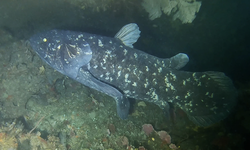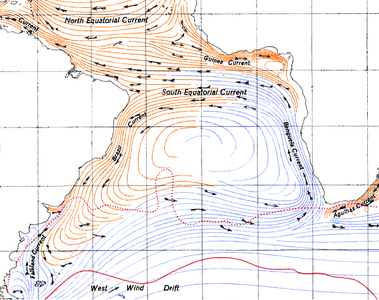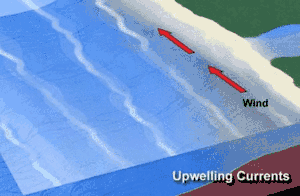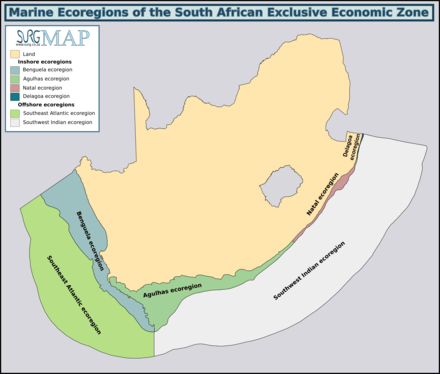Marine biodiversity of South Africa
The Marine biodiversity of South Africa is the variety of living organisms that live in the seas off the coast of South Africa. It includes genetic, species and ecosystems biodiversity in a range of habitats spread over a range of ecologically varied regions, influenced by the geomorphology of the seabed and circulation of major and local water masses, which distribute both living organisms and nutrients in complex and time-variable patterns.

History
National Biodiversity Assessments
The National Biodiversity Assessment (NBA) is recurring project by the South African National Biodiversity Institute in collaboration with the Department of Environmental Affairs and several other organisations to assess the state of South Africa’s biodiversity over time as an input for policy and decision making where the environment may be affected. The NBA looks into genetic, species and ecosystems biodiversity for terrestrial, freshwater, estuarine and marine environments. Each assessment cycle takes approximately five years, and both generates new knowledge and analyses existing knowledge[1]
Physical oceanography
Physical oceanography is the sub-domain of oceanography which focuses on the study of physical conditions and processes within the ocean, including the physical properties and circulation of ocean waters. These matters influence the biodiversity by providing the setting in which the ecology and biodiversity evolve.
The physical setting for the biodiversity of the South African coastal and offshore waters is mainly temperate continental shelf, slope and abyss in the South Atlantic and South-west Indian Oceans off the southern part of the continent of Africa. The geomorphology of this region has local effects on the ocean circulation, particularly effects on ocean currents and upwellings, which in turn affect the distribution of organisms and the environment in which they live.
Continental shelf
The continental shelf of southern Africa varies considerably in width along the coast, and the shelf edge also varies in depth. To the north-east the shelf is narrow to very narrow, with a relatively shallow break, but it is much wider over the Agulhas Bank off the southern tip of the continent. This gradual increase in width affects the path of the powerful Agulhas Current, pushing it further offshore towards the Southern Ocean.
Ocean currents



The Agulhas Current is the western boundary current of the southwest Indan Ocean. It flows south along the African east coast and along the south-eastern edge of the bank. It then retroflects back into the Indian Ocean south-west of the bank. This retroflection results in intense eddy activities such as meanders, eddies, and filaments.[2] In upper layer water, the Agulhas rings and eddies move warm and salty water into the large South Atlantic gyre, which exports it to the tropics. In the lower ocean layers water is transported in the opposite direction.[3]
The Agulhas acts as an oceanic convergence zone. Due to mass continuity this drives surface waters down, resulting in the upwelling of cold, nutrient rich water south of the current. Additionally, the convergence tends to increase the concentration of plankton in and around the Agulhas. Both of these factors result in the area being one of enhanced primary productivity as compared to the surrounding waters. This is especially notable in the Agulhas Retroflection waters, where chlorophyll-a concentrations tend to be significantly higher than the surrounding South Indian Ocean and South Atlantic Ocean waters.[4] Warm core rings are known to have lower primary productivity than surrounding cold waters. Agulhas Rings have been observed to carry waters with low chlorophyll-a concentration water into the South Atlantic. The size of phytoplankton in Agulhas Rings tends to be smaller than in the surrounding water (around 20 µm in diameter).[4] Agulhas Rings have also been observed as removing larval and juvenile fish from the continental shelf.
The Benguela Current is the broad, northward flowing ocean current that forms the eastern portion of the South Atlantic Ocean gyre. The current extends from roughly Cape Point in the south, to the position of the Angola-Benguela front in the north, at around 16°S. The current is driven by the prevailing south easterly trade winds. Inshore of the Benguela Current proper, the south easterly winds drive coastal upwelling, forming the Benguela Upwelling System. The cold, nutrient rich waters that upwell from around 200–300 m depth in turn fuel high rates of phytoplankton growth, and sustain the productive Benguela ecosystem.
Upwellings

Upwelling is an oceanographic phenomenon that involves wind-driven motion of surface water away from the coast, which is replaced by a flow of deeper dense, cooler, and usually nutrient-rich water towards the ocean surface, The nutrient-rich upwelled water stimulates the growth and reproduction of primary producers such as phytoplankton. Due to the biomass of phytoplankton and presence of cool water in these regions, upwelling zones can be identified by cool sea surface temperatures (SST) and high concentrations of chlorophyll-a.[5][6] The increased availability of nutrients in upwelling regions results in high levels of primary production. Upwellings that are driven by coastal currents or diverging open ocean have the greatest impact on nutrient-enriched waters and global fishery yields.[7][4]
Ecological regions

The marine ecoregions of the South African exclusive economic zone are a set of geographically delineated regions of similar ecological characteristics on a fairly broad scale, covering the exclusive economic zone along the South African coast. There were originally five inshore bioregions over the continental shelf and four offshore bioregions covering the continental slope and abyssal regions. These bioregions are used for conservation research and planning. They were defined in the South African National Spatial Biodiversity Assessment of 2004.[8] The South African National Spatial Biodiversity Assessment of 2011 amended this to reduce the number of regions to four inshore and two offshore and rename them as ecoregions.[9]
Species lists
National
Marine animals
- List of comb jellies of South Africa
- List of echinoderms of South Africa
- List of marine and coastal birds of South Africa
- List of marine arthropods of South Africa
- List of marine bristleworms of South Africa
- List of marine bryozoans of South Africa
- List of marine cnidarians of South Africa
- List of marine fishes of South Africa
- List of marine flatworms of South Africa
- List of marine mammals of South Africa
- List of marine molluscs of South Africa
- List of marine reptiles of South Africa
- List of sponges of South Africa
Seaweeds
Prokaryotes
Research organisations
- Council for Scientific and Industrial Research (CSIR) – South Africa's central and premier scientific research and development organisation
- Iziko South African Museum – A South African national museum in Cape Town
- South African Association for Marine Biological Research – Non profit conservation research organisation based in Durban, SA
- South African Environmental Observation Network (SAEON) – A network of people, organisations and observation platforms, that perform Long-Term Ecological Research in South Africa and surrounding waters
- South African Institute for Aquatic Biodiversity (SAIAB) – Centre for the study of aquatic biodiversity in Grahamstown, South Africa
- South African National Biodiversity Institute (SANBI) – Institution under the South African Department of Environmental Affairs
Publications
Books
Field guides:
- Atkinson, LJ; Sink, KJ, eds. (2018). Field Guide to the Offshore Marine Invertebrates of South Africa (PDF). Pretoria: Malachite Marketing and Media. doi:10.15493/SAEON.PUB.10000001.
- Branch, G.M.; Branch, M.L. (1985). The Living Shores of Southern Africa (3rd impression ed.). Cape Town: C. Struik. ISBN 0 86977 115 9.
- Branch, G.M.; Branch, M.L.; Griffiths, C.L.; Beckley, L.E. (2010). Two Oceans: a guide to the marine life of southern Africa (2nd ed.). Cape Town: Struik Nature. ISBN 978 1 77007 772 0.
- Day, J.H. (1969). A guide to marine life on South African shores. Cape Town: Balkema.
- De Clerck, O.; Bolton, J.J.; Anderson, R. J.; Coppejans, E. (2005). Guide to the Seaweeds of KwazZulu-Natal. Scripta Botanica Belgica Volume 33. Joint publication of: National Botanical gardens of Belgium, VLIZ Flanders Marine Institute and Flemish Community. ISBN 90-72619-64-1.
- Gosliner, T.M. (1987). Nudibranchs of Southern Africa. ISBN 0-930118-13-8.
- Jones, Georgina (2008). A field guide to the marine animals of the Cape Peninsula. Cape Town: SURG. ISBN 978-0-620-41639-9.
- Heemstra, Phil; Heemstra, Elaine (2004). Coastal Fishes of Southern Africa. NISC/SAIAB. ISBN 1920033017.
- Kilburn, R.; Rippey, E. (1982). Sea Shells of Southern Africa. Macmillan. ISBN 0-86954-094-7.
- King, Dennis (1996). Reef fishes and corals: East coast of southern Africa. Cape Town: Struik. ISBN 1 86825 981 1.
- King, D.; Fraser, V. (2001). More Reef Fishes and Nudibranchs. Cape Town: Struik. ISBN 1-86872-686-X.
- King, Dennis; Fraser, Valda (2014). The Reef Guide: East and South Coasts of Southern Africa. Cape Town: Struik Nature. ISBN 9781775840183.
- Liltved, William Rune (2000). Cowries and their relatives of southern Africa: A study of the southern African Cypraeacean and Velutinacean gatropod fauna (2nd ed.). Gordon Verhoef, Seacomber Publications. ISBN 0908 42089 7.
- Smith, Margaret M; Heemstra, P., eds. (2003). Smith's sea fishes. Cape Town: Struik. ISBN 1 86872 890 0.
- Smith, J.L.B.; Smith, Margaret M. (1966). Fishes of the Tsitsikamma Coastal National Park. Johannesburg: Swan Press.
- Stegenga, H.; Bolton, J.J.; Anderson, R.J. (1997). Seaweeds of the South African West Coast. Contributions from the Bolus Herbarium, University of Cape Town. ISBN 0-7992-1793-X.
- Steyn, D.G.; Lussi, M. (2005). Offshore Shells of Southern Africa. ISBN 0-620-33607-2.
- Zsilavecz, Guido (2005). Coastal fishes of the Cape Peninsula and False Bay: A divers' identification guide. Cape Town: SURG. ISBN 0-620-34230-7.
- Zsilavecz, G. (2007). Nudibranchs of the Cape Peninsula and False Bay. Cape Town: SURG. ISBN 0-620-38054-3.
Journals
- Annals of the South African Museum
Reports
- South African National Spatial Biodiversity Assessment 2004
- Summary Report
- Driver, A., Maze, K., Lombard, A.T., Nel, J., Rouget, M., Turpie, J.K., Cowling, R.M., Desmet, P., Goodman, P., Harris, J., Jonas, Z., Reyers, B., Sink, K. & Strauss, T. 2004. South African National Spatial Biodiversity Assessment 2004: Summary Report. Pretoria: South African National Biodiversity Institute.
- Technical Reports
- Volume 3: Estuary Component
- Turpie, J.K. 2004. South African National Spatial Biodiversity Assessment 2004: Technical Report. Volume 3: Estuary Component. Pretoria: South African National Biodiversity Institute.
- Volume 4: Marine Component
- Lombard, A.T.; Strauss, T.; Harris, J.; Sink, K.; Attwood, C.; Hutchings, L. (2004). South African National Spatial Biodiversity Assessment 2004: Technical Report (PDF) (Report). Volume 4: Marine Component. Pretoria: South African National Biodiversity Institute.
- Volume 3: Estuary Component
- Summary Report
- National Biodiversity Assessment 2011
- Sink, K; Holness, S; Harris, L; Majiedt, P; Atkinson, L; Robinson, T; Kirkman, S; Hutchings, L; Leslie, R; Lamberth, S; Kerwath, S; von der Heyden, S; Lombard, A; Attwood, C; Branch, G; Fairweather, T.; Taljaard, S.; Weerts, S.; Cowley, P.; Awad, A.; Halpern, B.; Grantham, H; Wolf, T. (2012). National Biodiversity Assessment 2011: Technical Report (PDF) (Report). Volume 4: Marine and Coastal Component. Pretoria: South African National Biodiversity Institute.
National Biodiversity Assessment for 2018 (NBA2018)
See also
- Biodiversity – Variety and variability of life forms
- Ecology – Scientific study of the relationships between living organisms and their environment
- Marine biodiversity – The variety of living organisms that live in the seas
- Marine biology – The scientific study of organisms that live in the ocean
- Marine protected areas of South Africa – Protected areas of coastline or ocean in the EEZ of South Africa
References
- "National Biodiversity Assessment". www.sanbi.org. Retrieved 14 February 2019.
- Blanke, B.; Penven, P.; Roy, C.; Chang, N.; Kokoszka, F. (2009). "Ocean variability over the Agulhas Bank and its dynamical connection with the southern Benguela upwelling system" (PDF). Journal of Geophysical Research. 114 (C12028): Introduction, pp. 1–2. Bibcode:2009JGRC..11412028B. doi:10.1029/2009JC005358. Retrieved 2 January 2015.CS1 maint: ref=harv (link)
- Ruijter, W. P. M., de; Cunningham, S. A.; Gordon, A. L.; Lutjeharms, J. R. E.; Matano, R. P.; Piola, A. R. (2003). "On the South Atlantic Climate Observing System (SACOS)" (PDF). Report of the CLIVAR/OOPC/IAI Workshop: 45. Retrieved 4 January 2015.
- Mann, K. H.; Lazier, J.R. (2006). Dynamics of Marine Ecosystems: Biological-Physical Interactions in the Oceans (3rd ed.). Blackwell Publishing. ISBN 978-1405111188.
- Anderson, DM; Prell, WL (1993). "A 300 KYR record of upwelling off Oman during the late quaternary: evidence of the Asian southwest monsoon". Paleoceanography. 8 (2): 193–208. Bibcode:1993PalOc...8..193A. doi:10.1029/93pa00256.
- Sarhan, T; Lafuente, JG; Vargas, M; Vargas, JM; Plaza, F (1999). "Upwelling mechanisms in the northwestern Alboran Sea". Journal of Marine Systems. 23: 317–331. doi:10.1016/s0924-7963(99)00068-8.
- Jennings, S.; Kaiser, M.J.; Reynolds, J.D. (2001). Marine Fisheries Ecology. Oxford: Blackwell Science Ltd. ISBN 0-632-05098-5.
- Lombard, A.T.; Strauss, T.; Harris, J.; Sink, K.; Attwood, C.; Hutchings, L. (2004). South African National Spatial Biodiversity Assessment 2004: Technical Report (PDF) (Report). Volume 4: Marine Component. Pretoria: South African National Biodiversity Institute.
- Sink, K; Holness, S; Harris, L; Majiedt, P; Atkinson, L; Robinson, T; Kirkman, S; Hutchings, L; Leslie, R; Lamberth, S; Kerwath, S; von der Heyden, S; Lombard, A; Attwood, C; Branch, G; Fairweather, T.; Taljaard, S.; Weerts, S.; Cowley, P.; Awad, A.; Halpern, B.; Grantham, H; Wolf, T. (2012). National Biodiversity Assessment 2011: Technical Report (PDF) (Report). Volume 4: Marine and Coastal Component. Pretoria: South African National Biodiversity Institute. p. 325. Note: This is the full document, with numbered pages.